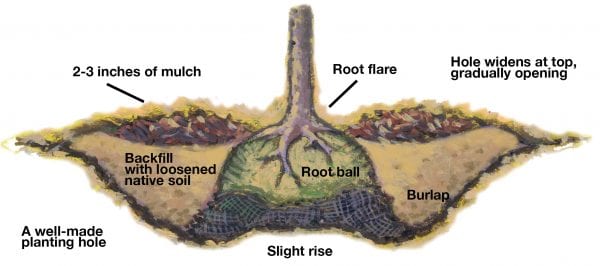Landscaping

Trees provide more than beauty. They give us a sense of history and well-being, make our communities more livable, provide habitat for wildlife, and shade our homes helping us save money on utility bills.
Every tree, large or small, began as a small seedling. Just as generations before us planted and nurtured trees that we enjoy today, we can have a major impact on our communities for years to come by helping to replace trees lost in storms. The following information will help you make wise plant choices and know how to properly plant and care for new trees in your landscape.
Right Plant – Right Place
Consider all the factors when selecting the best tree for each location. A tree should be suited to the location’s light exposure, soil drainage, and available space. Think about both the above- and belowground space needed for the mature canopy and root system of the tree.
Plant a mixture of tree species. Avoid overuse of any one species so that your landscape will be visually interesting and better able to weather storms and future pest outbreaks. For recommendations on what
to plant in your area, consult a local arborist, Extension horticulturist, or nursery professional, or visit one of the many arboretums or botanical gardens around the state.
When you have decided which tree to plant, think small— 1 to 3 inches in diameter at the base. Small trees are less expensive, easier to plant, and require less time to establish.
He plants trees to benefit another generation. ~ Caecilius Statius (220 BC-168 BC)
Planting for Success
Soil improvement and preparation as well as proper planting space are critical for a good start and long-term tree health. A soil analysis is inexpensive and provides valuable information to help you select trees and learn what soil nutrient and pH adjustments may be needed. Find soil testing information at your county Extension office or visit the Auburn University Soil Testing Lab website at www.aces.edu/soiltest.
Always call 811 to locate water and utility lines before digging. When your hole is dug, spread the root system out laterally. Cut circling roots that could grow around and girdle the tree trunk in the future.

Set plants at the proper depth by finding the uppermost lateral root and keep it at or near the soil surface. For container-grown plants, wash and remove most of the organic mix from the root ball to expose the root system and to make needed root corrections. Remove the top third of burlap from balled and burlapped bags; or, if the bag is made from a synthetic material, remove as much of the bag as possible.
Plant trees in large, wide holes rather than in narrow, deep ones. Do not dig the hole deeper than the root ball of the tree being planted. If the soil has a poor texture—either too sandy or too heavy—add loose, loamy topsoil and composted organic matter in an area as wide as possible and not just to the planting hole. Till any soil amendments, such as organic matter, topsoil, or lime, into the entire planting area.
The best time to plant a tree was 20 years ago. The next best time is now. ~Chinese Proverb
After-Planting Care
With an adequate watering schedule, container-grown trees can be planted at any time. The best times to plant in Alabama, especially for balled and burlapped or bare-root trees, are fall and winter. Planting in fall or early winter reduces planting stress and water needs compared to planting in warmer seasons.
Watering is critically important at any planting time. When a tree is first planted, add water slowly every day or two at a rate of about 2 gallons per inch of trunk diameter. After a few weeks, decrease the frequency but increase the volume and expand it to a wider area to encourage wide-spreading roots. You may need to water for 6 months or even a year depending on the size of the tree and the time of year you plant.
Pruning is not usually necessary the first year except to remove dead, rubbing, or broken limbs. Fertilization
is usually not needed the first year and may encourage excessive vegetative growth at the expense of root growth. If the pH is too low you may add lime as recommended to the planting area prior to planting.
Finally, create a weed and grass-free mulch ring around the tree to protect it from string trimmer and lawn mower damage. Apply about 3 inches of mulch in a ring around the plant, but avoid direct contact with the trunk.
In future years you may use fertilizers according to the soil test recommendations. Trees are in a juvenile stage for the first few years of their lives, and fertilization can greatly increase the growth rate. Fertilize in an area at least as far out as the limb spread, and increase the mulch ring to that same area as the tree matures.
Download a PDF of Tree Selection, Planting & Care, ANR-1405.

